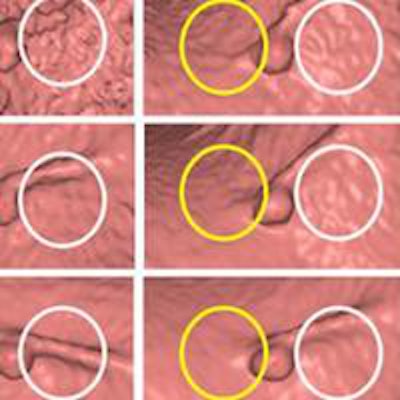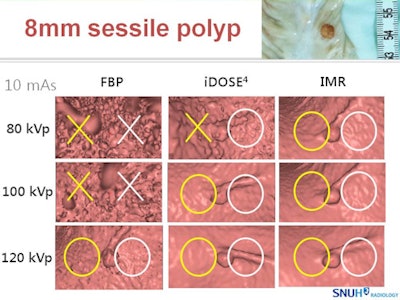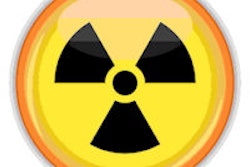
CHICAGO - Researchers from Seoul, South Korea, achieved record-skimming low doses in a CT colonography (CTC) phantom study that also delivered high image quality and comparable diagnostic performance to conventional CTC.
Thanks to the use of advanced iterative reconstruction, the group from Seoul National University Hospital achieved its high image quality with radiation doses of less than 0.2 mSv per phantom-based acquisition, a step beyond previous studies that struggled to achieve diagnostic image quality at 80 kVp.
"With the aid of a knowledge-based iterative reconstruction algorithm [iterative model reconstruction, Philips Healthcare], 80-kVp virtual colonoscopy is feasible and shows significant image noise reduction and comparable per-polyp sensitivity to conventional 120-kVp CT colonography," said Dr. Cheong-Il Shin in her presentation.
 Presenter Dr. Cheong-Il Shin (left), with principal investigator Dr. Se Hyung Kim.
Presenter Dr. Cheong-Il Shin (left), with principal investigator Dr. Se Hyung Kim.
Radiation doses for CTC in the clinical setting are already considered low -- in the range of 4 to 6 mSv per prone/supine image dataset. However, radiation dose remains a concern because patients undergo the exam every five years between the ages of 50 and 80 to comply with colorectal cancer screening guidelines. Previous studies have performed the exam successfully with CT settings as low as 100 kVp, but investigators have struggled to reduce tube voltage settings to 80 while retaining readable images.
"Dose reduction must be balanced by an acceptable level of image quality in order to maintain diagnostic accuracy," Shin said.
Various iterative reconstruction techniques reduce noise by iteratively comparing conventional filtered back projection (FBP) to modeled projections. Hybrid iterative reconstruction (iDose4, Philips) allows the user to control image quality and dose. Iterative model reconstruction (IMR) is an advanced knowledge-based reconstruction scheme that offers dose reductions of up to 80% and enhanced low-contrast detectability.
The study evaluated the performance of ultralow-dose 80-kVp CT colonography using each of the reconstruction schemes to determine if CTC is feasible at settings of 80 kVp and 10 mAs for data acquired in an anthropomorphic pig phantom model.
Images were acquired on a 256-detector-row MDCT scanner (Brilliance iCT, Philips) using detector collimation of 0.625 mm x 128 and slice thickness and reconstruction intervals of 1 mm and 0.9 mm, respectively.
The phantoms were scanned at 80, 100, and 120 kVp -- all set at 10 mAs -- and the results were examined for image quality and lesion detectability when reconstructed with FBP, iDose4, and IMR, Shin said. In all, there were 63 datasets, representing nine image sets times seven phantoms.
 Image courtesy of Dr. Cheong-Il Shin and Dr. Se Hyung Kim.
Image courtesy of Dr. Cheong-Il Shin and Dr. Se Hyung Kim.Two radiologists, one CTC expert and one novice, compared the datasets using each of the different parameters for image quality and detectability. Their reported per-polyp sensitivities were analyzed by a binomial test corrected by Bonferroni post-hoc analysis.
Reducing the tube voltage from 120 to 80 produced a 70.7% drop in CT dose index volume (CTDIvol), and moving from 100 to 80 kVp reduced CTDIvol by 50.5% (p = 0.014), the group reported. The effective radiation dose at 80 kVp was 0.17 mSv.
With FBP reconstruction, dropping to 80 kVp increased image noise by 67.8% (from 120 kVp) and 45.5% (from 100 kVp).
| Dose with different kVp at 10 mAs | |||||
| 120 kVp | 100 kVp | 80 kVp | |||
| CTDIvol (mGy) | 0.71 ± 0.01 | 0.42 ± 0.01 | 0.21 ± 0.6 | ||
| DLP (mGy-cm) | 38.17 ± 0.77 | 22.66 ± 0.66 | 11.04 ± 0.3 | ||
| mSv (effective dose) | 0.57 | 0.34 | 0.17 | ||
| Image noise with varying kVp and iterative reconstruction | |||||
| FBP | iDose4 | IMR | |||
| 80 kVp | 201.97 | 95.26 | 31.82 | ||
| 100 kVp | 139.11 | 61.26 | 19.24 | ||
| 120 kVp | 120.43 | 40.89 | 13.74 | ||
| Per-polyp sensitivity (expert reader) | |||||
| FBP | iDose4 | IMR | |||
| 120 kVp | 85.3 | 98.5 | 100 | ||
| 100 kVp | 57.4 | 95.6 | 100 | ||
| 80 kVp | 14.7 | 79.4 | 98.5 | ||
"Performing CTC at 80 kV would not be feasible without iterative reconstruction, although there is a significant dose reduction compared with 100 and 120 kVp CTC," Shin said. "However, using knowledge-based iterative reconstruction, there is significant noise reduction ... and comparable sensitivity to conventional 120-kV CTC."




















